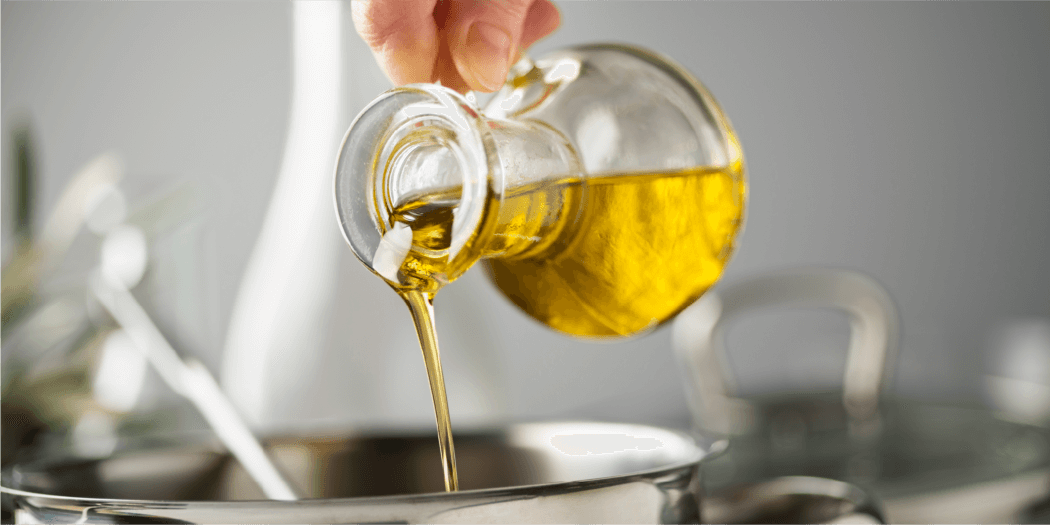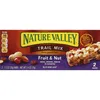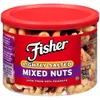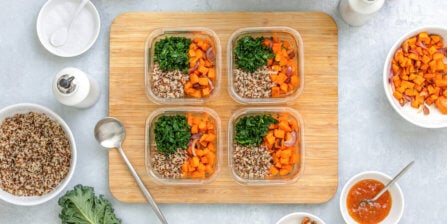Planning & Prep
Oil-to-Butter Conversion: Guide to Butter Substitutes

Pausing your cooking to convert ingredients is never fun. Perhaps your recipe calls for oil, but you only have butter in your fridge. What happens if you’re making pancakes and you only have oil? Thankfully, you can use our oil-to-butter conversion without compromising the taste or texture of your recipe. We crunched the numbers and even provided a few butter substitutes to guide you.
Table of Contents:
- How to convert oil to butter
- How to convert butter to oil
- Oil-to-butter conversion chart
- Butter substitutes
How to convert oil to butter

You can convert cooking oil to butter with a 1:1 ratio. This method of swapping oil for butter works with most oils, including olive, vegetable and canola oil. Make sure the butter is cool or at room temperature before mixing it into your recipe.
| Example: If a recipe calls for 1 cup of oil, use 1 cup of cool or melted butter instead. |
How to convert butter to oil

You can substitute butter for oil, but it may alter the flavor and level of moisture. To convert butter to oil, you’ll want to use a 3:4 ratio instead — this means one equal part of oil equates to ¾ butter.
| Example: If a recipe calls for 2/3 cup of butter, use 1/2 cup of oil instead. |
However, this is only if you’re using vegetable, canola or olive oil. If you’re replacing butter with coconut oil, you can use a 1:1 ratio.
Grab it now on Instacart:










Oil-to-butter conversion chart
Still unsure of how to use the oil-to-butter conversion metrics? Here are some common standard metric conversions for butter to oil and vice versa.
Oil to butter (standard metrics)
Check out the standard metrics for converting oil to butter below.
| Oil | Butter |
| ¾ teaspoon | 1 teaspoon |
| 2 ¼ teaspoons | 1 tablespoon |
| 1 ½ tablespoons | 2 tablespoons |
| 3 tablespoons | ¼ cup (1/2 stick) |
| ¼ cup + 2 tablespoons | ½ cup (1 stick) |
| ½ cup | ⅔ cup |
| ½ cup + 1 tablespoons | ¾ cup |
| ¾ cup | 1 cup (2 sticks) |
| 1 ½ cup | 2 cup (4 sticks) |
Oil to butter (mL)
Not sure how to convert oil to butter in mL? Reference our chart below for common conversions.
| Oil | Butter |
| 75 ml | 100 ml |
| 150 ml | 200 ml |
| 225 ml | 300 ml |
| 300 ml | 400 ml |
| 375 ml | 500 ml |
| 450 ml | 600 ml |
| 525 ml | 700 ml |
| 600 ml | 800 ml |
| 675 ml | 900 ml |
| 750 ml | 1000 ml |
Oil to butter (grams to mL)
Use the grams to mL oil to butter chart below to convert common measurements. You can also bookmark our grams to mL converter to calculate other common ingredients.
| Oil | Butter |
| 83 ml | 100 g |
| 166 ml | 200 g |
| 249 ml | 300 g |
| 332 ml | 400 g |
| 415 ml | 500 g |
| 498 ml | 600 g |
| 581 ml | 700 g |
| 664 ml | 800 g |
| 747 ml | 900 g |
| 830 ml | 1000 g |
Common butter substitutes
No big deal if you run out of butter when cooking! Here are a few common butter substitutes that get the job done.

1. Olive oil
If you’re replacing butter with oil, you can follow a 3:4 ratio. This means you would use ¾ the amount of olive oil a recipe calls for butter. Try swapping butter for olive oil in your savory dishes, for example, this beef and broccoli recipe.
How much to use: 3:4 ratio
Best for: Cooking and sauteing
2. Coconut oil
Coconut oil is a dairy-free, vegan butter substitute. Although coconut oil can replace butter, it has a distinctive flavor that can alter some dishes. Try using coconut oil to replace butter in this chicken curry recipe, or add it to make a box cake taste better.
How much to use: 1:1 ratio
Best for: Curry, stir-fry and desserts
3. Unsaturated oils
Unsaturated oils like canola, sunflower or vegetable oil can replace butter for most recipes. Swap the butter for one of the flavorless, unsaturated oils in baked goods, including cupcakes, cookies and even your favorite banana bread recipe.
How much to use: 1:1 ratio
Best for: Baked goods or any recipe that requires high heat
4. Mayonnaise
While it may not sound appealing, mayonnaise is a mixture of egg yolks and oil, making an easy butter substitute. You can use mayonnaise for extra moisture in mashed potatoes and other savory dishes. Try melting it down for grilled cheese or omelets.
How much to use: 1:1 ratio
Best for: Savory dishes, dips and sauces
5. Margarine
Margarine is one of the most common substitutes for butter because of its similar texture. If you have a dairy allergy or sensitivity, keep in mind that not all margarines are dairy-free. Cook or bake with margarine the same way you use butter.
How much to use: 1:1 ratio
Best for: Baking and cooking
6. Yogurt
Swap butter for full-fat yogurt to maintain the richness and texture. Stick to a 1:1 ratio when using yogurt instead of butter. However, if you’re following a recipe that calls for a large amount of butter, try Greek yogurt instead because of its low moisture content.
How much to use: 1:1 ratio
Best for: Baked goods
7. Vegetable shortening
Use vegetable shortening instead of butter for recipes that don’t need the buttery flavor. Vegetable shortening has a high melting point compared to butter, so your sweet treats will be light and airy.
How much to use: 1:1 ratio
Best for: Baked goods
8. Vegan butter
Most kinds of vegan butter are made from vegetable and nut oils and can replace natural butter. Vegan butter works well as a butter alternative for almost any recipe, especially for baked goods. Stick to the 1:1 ratio to swap for vegan butter in your recipes.
How much to use: 1:1 ratio
Best for: Baking and cooking
9. Applesauce
Transform the lightness of your baked goods by using applesauce instead of butter. Choose unsweetened applesauce because apples are naturally sweet. However, if you only have sweetened applesauce in the house, you can adjust the sugar level in your recipe.
How much to use: 1:1 ratio
Best for: Baked goods
Factors to consider when choosing butter substitutes

When selecting a butter substitute, you should consider a few factors to ensure your dish turns out just right. Different substitutes can affect flavor, texture and overall satisfaction, so understanding your specific needs is key.
Here are some important factors to think about when choosing the right butter alternative for your recipe:
- Recipe type: Baking recipes may require different substitutes than those for cooking or spreading.
- Desired flavor: Some substitutes, like olive oil, add a distinct flavor, while others, like vegetable shortening, may have a neutral taste.
- Dietary restrictions: Consider any dietary needs, such as lactose intolerance, vegan preferences or allergies.
- Texture requirements: Different substitutes can impact the texture of your dish, especially in baking, where moisture and fat content are crucial.
- Cooking method: Some substitutes may not perform well at high temperatures — consider how you plan to use the butter alternative.
Oil-to-butter conversion FAQ
When cooking and baking, knowing how to convert between oil and butter is essential for achieving the right texture and flavor. Whether you’re out of an ingredient or want to try healthier options, these conversions will guide you. Here are some common questions about oil-to-butter conversions.
One stick of butter is equivalent to about 1/2 cup, which translates to approximately 1/3 cup of oil. While butter contains about 80% fat and 20% water, oils are 100% fat. Therefore, you may want to use slightly less oil to account for the moisture content in butter in recipes that require precise measurements.
To substitute 1/2 cup of oil, you can use about 2/3 cup of butter. Since butter contains water, using more butter helps replicate the fat content while maintaining the recipe’s moisture balance. This conversion is particularly useful in baking, where moisture is essential for texture.
To convert 1/3 cup of oil to butter, you would typically use about 1/2 cup of butter. This adjustment ensures that the recipe retains its intended moisture and richness, as butter’s water content needs to be considered when replacing oil.
If you’re looking to replace 1/4 cup of vegetable oil, you can use about 3/8 cup of butter, which is roughly 6 tablespoons. This conversion takes into account the differences in fat and moisture content between oil and butter, helping you maintain the desired consistency in your dish.
Additional cooking conversion resources
Use one of our additional cooking conversion resources to streamline your baking and cooking process.
- Cooking measurement conversion
- Cooking time calculator
- Grams to cups converter
- Oven temperature conversion chart
- Serving size calculator
Mastering the oil-to-butter conversion
You should now feel more confident in making oil-to-butter conversions. Remember to use the 1:1 ratio to convert oil to butter or the 3:4 ratio for butter to oil.
Cut down even more time by ordering your butter substitutions through Instacart. Add your ingredients to your virtual cart and enjoy your order right to your home.
Most Recent in Planning & Prep

Planning & Prep
37 Care Package Ideas: From “Get Well” to “Just Because”
It’s always nice to show some extra appreciation for your loved ones. Whether you want to support a sick friend or a neighbor who had their first child, a care package is the perfect way…
Jan 30, 2025
Planning & Prep
Average Grocery Cost per Month: The 2025 Breakdown
The average grocery cost per month, per person, in the United States is roughly $350 for adults between 19 and 50 years old in a four-person household. This estimation depends on multiple factors, such as…
Dec 23, 2024
Planning & Prep
33 Shocking Global and National Food Waste Statistics (2025)
Did you know nearly 30% of the food produced globally is never eaten? This staggering food waste statistic highlights the alarming issue of uneaten food — a problem with environmental, economic and social consequences. Food…
Dec 23, 2024


 17 Grocery List Categories to Make Shopping Easy
17 Grocery List Categories to Make Shopping Easy  How to Meal Plan: Step-by-Step Guide to Meal Planning
How to Meal Plan: Step-by-Step Guide to Meal Planning  How To Read Food Labels: Guide to Nutrition Labels
How To Read Food Labels: Guide to Nutrition Labels 

